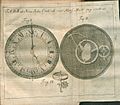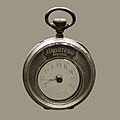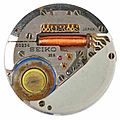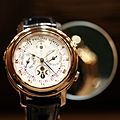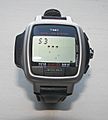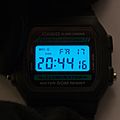Watch facts for kids
A watch is a small clock that a person carries or wears. It helps you easily see the time. Watches are also a popular fashion accessory for both guys and girls. Many expensive watches are made just for this reason. A watch might be one of the only accessories someone wears.
A wristwatch is made to be worn on your wrist. It is held on by a strap or a type of bracelet. A pocket watch is meant to be carried in a pocket. There are other kinds too! For example, Nurses often wear a watch attached to the front of their uniform. It hangs down from a short strap, and when they lift it, it's right-side up.
Wristwatches are great because they are easy to carry around compared to older, larger clocks.
Watches first started appearing in the 1600s. They developed from spring-powered clocks, which were around as early as the 1300s. In 1524, a person named Peter Henlein made the very first pocket watch. The first watches were completely mechanical, meaning they worked with gears and springs, like a tiny machine.
As technology got better, mechanical watches were mostly replaced by watches that use vibrating quartz crystals. These crystals create very accurate electronic pulses that keep time. Some watches even use radio technology to automatically correct their time and date! The first digital electronic watch was invented in 1970.
Electronic watches, also called quartz watches, have very few or no moving parts. They use a special quartz crystal that vibrates because of something called the piezoelectric effect. This means that when an electric voltage is applied to the crystal, it changes its shape and vibrates. It vibrates at a very steady speed, which helps the watch keep perfect time. Most quartz watches are electronic inside but still have mechanical hands on the watch face. This gives them a traditional look that most people prefer.
Some watches today are smartwatches. These are like tiny mobile devices, similar to smartphones, but much smaller and worn on your wrist.
Contents
History of Watches
Watches have changed a lot over hundreds of years. From early mechanical designs to modern smartwatches, each step brought new ways to tell time.
Early Mechanical Watches
The first watches were powered by springs. They were very different from the clocks we know today. These early watches were often large and not very accurate.
The First Pocket Watch
In 1524, Peter Henlein made the first pocket watch. This was a big step because it meant people could carry their timepieces with them. Before this, clocks were usually too big to move easily.
The Rise of Quartz Watches
In the 20th century, a new type of watch became popular: the quartz watch. These watches use a tiny vibrating crystal to keep time.
How Quartz Watches Work
Quartz watches are very accurate. They use a quartz crystal that vibrates at a steady rate when electricity passes through it. This vibration helps the watch measure time precisely. Most quartz watches still have hands, so they look like traditional watches.
Modern Watch Technology
Today, watches can do much more than just tell time. Technology has made them smarter and more connected.
Digital and Radio Watches
The first digital electronic watch came out in 1970. These watches show the time in numbers instead of with hands. Some modern watches can even connect to radio signals to get the exact time, making them incredibly accurate.
Smartwatches and Beyond
Smartwatches are like mini-computers on your wrist. They can do many things a smartphone can, like send messages, track your fitness, and even make calls. They show how far watches have come from their simple beginnings.
Images for kids
-
Drawing of one of his first balance springs, attached to a balance wheel, by Christiaan Huygens, published in his letter in the Journal des Sçavants of 25 February 1675. The application of the spiral balance spring (spiral hairspring) for watches ushered in a new era of accuracy for portable timekeepers, similar to that which the endulum had introduced for clocks in 1656.
-
Views of a liquid crystal display, both with electroluminescent backlight switched on (top) and switched off (bottom)
-
The Rolex Submariner, an officially certified chronometer
-
The Omega Speedmaster, selected by NASA for use on space missions in the 1960s.
-
Astronaut Nancy J. Currie wears the Timex Ironman Triathlon Datalink model 78401 during STS 88.
-
A silver Pulsar LED watch from 1976.
See also
 In Spanish: Reloj (complemento) para niños
In Spanish: Reloj (complemento) para niños





